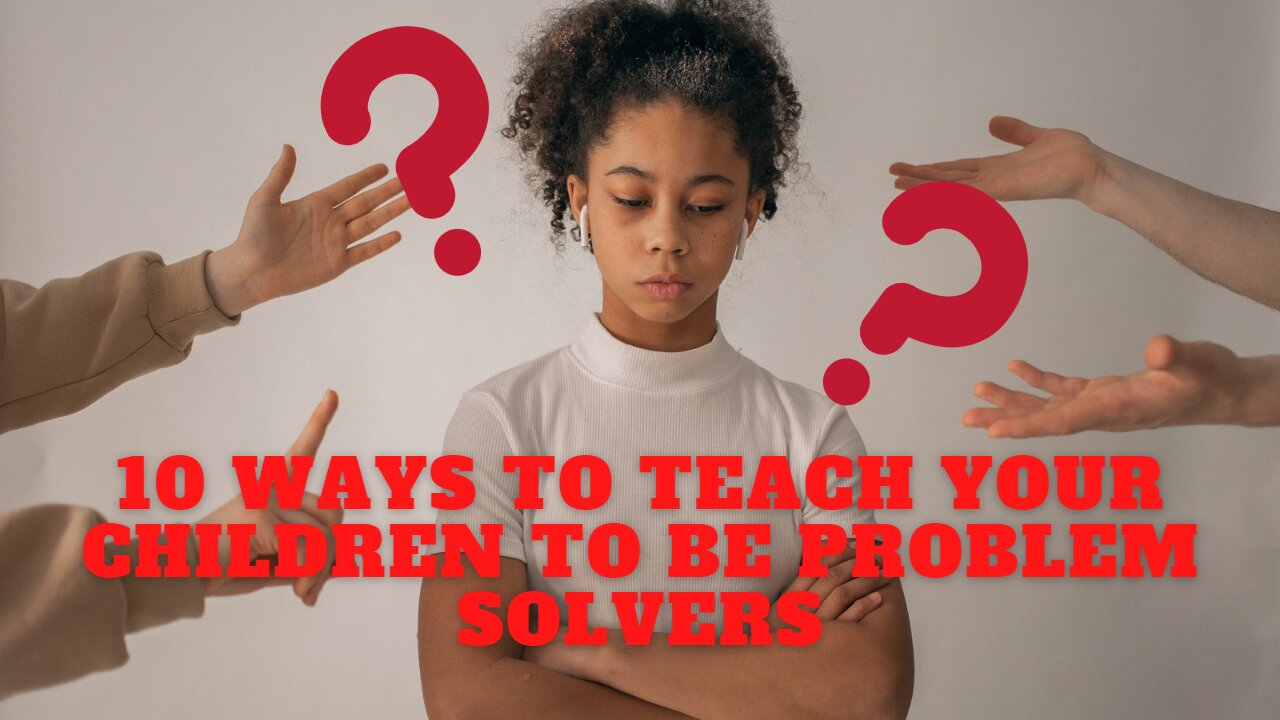Premium Only Content

10 Ways to Teach your Children to be Problem Solvers - POSITIVE HOWS
Moms wear a lot of hats for their kids: cook, chauffeur, party planner, the list is endless. But, the hat we need to wear less often is that of a problem solver. Sure, we can guide our children and offer comfort when they’re struggling, but the next time they start whining or saying something is impossible, delegate the job of problem-solving to them. Ask them what they should do about it. Tell them to come up with at least one solution. Let them think through the problem before you step in. Then perhaps give them a problem-solving method that will help them moving forward.
Here’s how to teach your children to be problem solvers.
1. Don’t be a “Helicopter Parent.”
Give your child some space. Whatever age they are, allow them to make mistakes. Then, teach them how to move forward.
2. Encourage creative play.
Remember wooden blocks? How about building a fort from the available material? Kids of all ages learn most in the context of play. Make sure their play involves enough challenge and requires imagination. Eventually, problem-solving becomes its own reward.
3. Don’t remove the occasional roadblock from their experience.
This is the opposite of solving your kids’ problems. If the difficulty is reasonable, you can help your child brainstorm a solution, but don’t solve the problem for them.
4. Provide multiple potential solutions.
Whenever it is possible, facilitate decision making. Keep the ball rolling by making sure your kids don’t routinely avoid making tough choices because you automatically issue a default solution that’s non-negotiable.
5. Make problem-solving a fun part of the culture of your home.
Make surmounting difficulties fun! We all run into problems, all the time, so why not make surmounting family challenges with a positive attitude simply the way your household does business. It’s important that your child be part of a problem-solving culture, and that they understand parents need to solve problems too.
6. Read problem-solving stories together.
In his classic young adult novel, Hatchet, author Gary Paulsen tells the story of a teen lost in the wilderness. The youngster survives by keeping his wits about him and solving problems as they come along. For girls, Wheel on the School shows a girl taking action. For younger kids, read them Encyclopedia Brown. It will get them thinking.
7. Try some DIY projects together.
Not handy? No problem. Learn together. In fact, the more your child sees you in action, problem-solving step by step, the more of a problem solver your child will become.
8. Learn basic problem solving method.
a. Identify the problem (for example, “I always miss the school bus.”).
b. Break the problem into manageable parts, so that each task does not seem impossible.
I save my homework for the morning.
I get out of bed late.
I can never find my backpack.
c. Tackle the parts, one at a time (not you, your kid!), until the problem is solved.
d. Bask in the glory of a job well done!
9. Allow children to experience failure.
If we’re unwilling to see our children fail at a task, then we’re unwilling for our children to learn.
10. Routinely ask your kids for help.
Make sure the children understand that you respect their capacity to solve problems. “I don’t know how we’re going to afford a big Christmas this year. What do you think?” You’d be surprised at how creative they can be. It’s also important that they see themselves as valued contributors to solutions.
#positivehows
-
 0:59
0:59
Positive Hows
1 year agoBoost Your Aura, Attract Positive Energy, Positive Energy Cleanse 7 Chakra Balancing
51 -
 41:55
41:55
Man in America
18 hours ago🔴 LIVE: The Cabal’s Most Powerful Weapon is COLLAPSING
121K87 -
 6:26:01
6:26:01
Jerry After Dark
18 hours agoJerry After Dark: Carnival Games
144K8 -
 3:55:04
3:55:04
ThatStarWarsGirl
13 hours agoTSWG LIVE: Big NEWS! Plus Reacting to Woke Meltdowns!
124K23 -
 8:02:46
8:02:46
FusedAegisTV
14 hours ago『AST lvl 100』Tuesday Raid & Rant | Final Fantasy XIV | Patch 7.1 Day of Reckoning!
84.4K2 -
 59:17
59:17
Matt Kohrs
15 hours agoRumble's Q3 Recap & What's Next w/ CEO Chris Pavlovski
102K30 -
 1:43:47
1:43:47
Adam Does Movies
19 hours ago $29.70 earnedGladiator II Early Reviews + Tom Cruise Stans Glen Powell + Freddy Krueger - Movie News LIVE!
92.4K3 -
 2:24:03
2:24:03
WeAreChange
15 hours agoTrump Creates Department Of Government Efficiency With Elon And Vivek!
150K102 -
 2:10:32
2:10:32
Slightly Offensive
17 hours ago $33.41 earnedGET READY: Civil Unrests ERUPTS As Trump Resistance 2.0 EMERGES
86.3K104 -
 59:40
59:40
The StoneZONE with Roger Stone
13 hours agoShowdown in the Republican US Senate Caucus - RINOs Seek to Undermine Trump | The StoneZONE
80.5K46